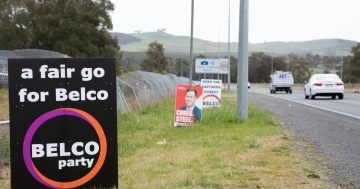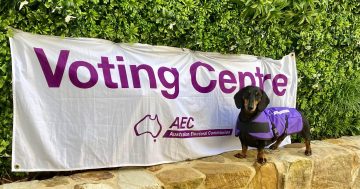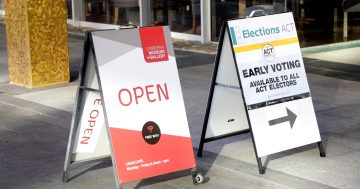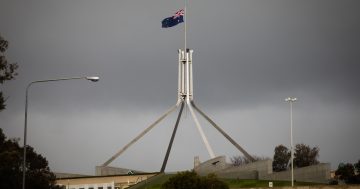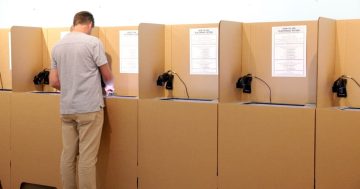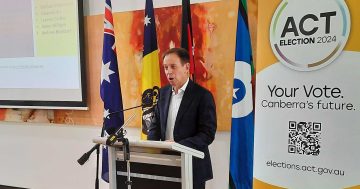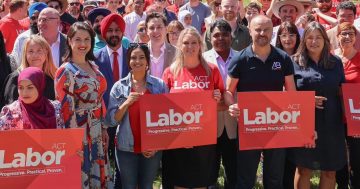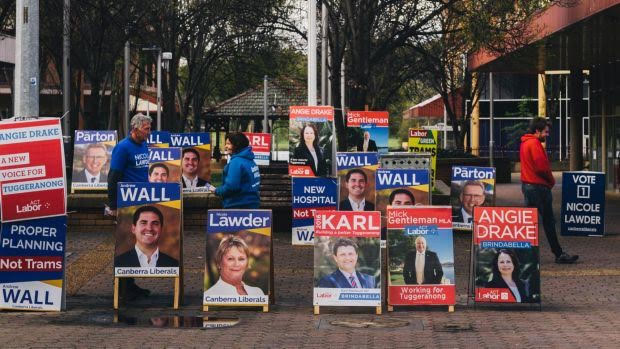
Kim Huynh considers how election signs and apps can address disillusionment and get Canberrans fired up about politics. This is the second part of his submission to the Select Committee on the 2016 Election and Electoral Act. The first part on divisions and donations can be read here.
As an independent candidate in last year’s ACT election I was invited to make a submission to a parliamentary committee that’s looking into how we can improve and advance democracy in the nation’s capital.
My focus is on how to i) quell the furore over campaign signs and ii) get more Canberrans engaged in and perhaps even excited about local politics.
Signs, Signs, Signs, Signs, Signs
One of ACT Electoral Commission’s recommendations to the committee was that campaign signs be restricted to designated parts of arterial roads.
There were in fact fewer formal complaints lodged about signs in 2016 (13) than there were in 2012 (28).
However, public criticism of the proliferation of signs in the media was sustained and at times vociferous. Most of the criticism was directed at the sheer number of signs and their perceived unsightliness, along with the environmental cost of producing so much plastic.
While I’m sympathetic to these concerns, placing further restrictions on signs would do little good and potentially harm our city’s political wellbeing.
On the matter of visual pollution, much of the distaste for the signs was a product of political disillusionment in general. The results of the Brexit vote, the US presidential race and the federal election highlighted how eager people were to give the ‘up yours’ to the establishment. Moreover, widespread coverage of these events meant that by October many Canberrans were fed up with elections and all the doctored images and hackneyed slogans by the roadside.
It’s far better to address this disillusionment than try to manage its symptoms by regulating signs and undercutting our freedom of political expression.
This is a long-term and difficult challenge that involves enhancing education and participation. However, all of us can adjust our attitudes and behaviour in ways that make an immediate and positive difference.
For those who are sick of election signs, there’s something to be said for sucking it up a bit more. After all, they’re only up for six weeks every four years and are then promptly removed. Canberrans are already relatively well insulated from in-your-face political advertising given the blackout period in the week leading up to the election and the 100m leafleteer buffer zone around polling booths.
Campaign signs were not restricted to zones during the recent WA election and I don’t recall the sand gropers complaining about visual pollution. Many democracies around the world are awash with corflutes, flags, banners and public rallies at election time. They provide colour and vibrancy to festivals of democracy. And sadly, there’s no shortage of political prisoners around the world who have fought and died for what our signs ultimately represent.
Established parties are responsible for the growing disaffection towards election signs in the ACT. They produce the vast majority of them, most of which are bland and monotonous, some of which are negative and patronising. Big parties, like any big organisation, tend to be risk and creativity averse.
However, there were a handful of signs from party candidates that showed some panache. Liberal Party MLA, Guilia Jones was successful once again in the all-important name recognition stakes with her simple and elegant ‘G’s (see Dr Andrew Hughes’ blog for examples and more analysis). Labor’s Mark Kulasingham should be commended for his witty play on words and his appearance: ‘Bold. Bald’. And on other end of the hair spectrum, Tara Cheyne used her blazing red bouffant as the basis for a striking poster.
Taking all of this into account, I recommend maintaining the status quo when it comes to election signs and revisiting the regulation question after 2020. This will give the major parties and indeed everyone a chance to listen to the people and inject some quality content and personality into their political advertisements. Some candidates might even find a way to achieve more with less when it comes to signage.
If signs are restricted to certain roads, consideration should be given to independents and micro parties. Otherwise large established parties will likely bombard the designated areas, leaving little if any space for small newcomers. This undemocratic situation could be mitigated by reserving zones for independents and micro parties.
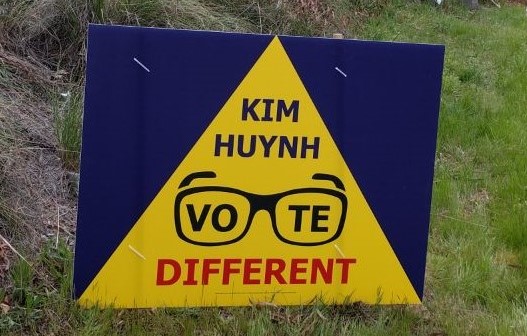
A Killer Election App
The Committee inquiring into the 2016 ACT election has also been charged with reviewing participation and education.
Elections ACT should be applauded for the fact that there was a record high turnout with over 88% of the eligible population casting a vote and a record low percentage of informal votes at 2.5%.
However, voter turnout – especially where it’s compulsory – is not a clear indicator of how aware and engaged we are in the political process. To this end, the Electoral Commission cites a 2007 Commonwealth inquiry into electoral education which found that young Australians between the ages of 15 and 35 commonly have little interest in polls and politics.
Get an election app and make it slick! For many people, young or otherwise, information and services that do not have apps are not worth knowing about.
This year Canberrans have been able to vote for Lucy Sugerman via The Voice app. The technology is not in place for there to be a 2020 ACT election app that allows for such voting. However, it would be relatively easy to come up with one that provides information about enrolment, boundaries, the electoral system, booths and background information.
Importantly, the app or an associate app could provide a place for candidates to set out their policies, biographies, pictures, public appearances and audio and video messages.
Whether voters are highly engaged or only tune for a few minutes before casting their ballot, an app would facilitate more informed and considered decision making.
To make the app more enticing, prizes could be awarded to randomly selected users. Other whiz bang value-adding features could be devised by local IT developers. I imagine integrating augmented reality – an election Pokémon perhaps – and a sophisticated gamification component, both of which could get people excited about democracy on their doorsteps.
The app should encourage user interaction, with one or two notable contributors being selected to perform an honorary act such as the ringing of a bell or blowing of a horn to mark the end of voting and the start of the count.
Given that the ACT has been at the forefront of electronic voting, it should also be ambitious and innovative when it comes to an election app.
The American and UK elections seem so full of action and character. Australians should not simply follow what they do, but rather look to forge a distinctive and dynamic path forth. Canberra is about politics; let’s not try to hide or deny it. Instead, we can be relaxed, comfortable and cool about politics and make it work for us.
Other than becoming a father, running for public office was the greatest thrill and honour of my life. It was at once immensely rewarding and taxing. I don’t think I could do it again. However, teaching hundreds of students a year, I believe that there are people out there who can do politics better than me. I ran not so much to win, but to encourage and inform them. I offer this submission to the Select Committee on the 2016 Election and Electoral Act with the same hope and purpose.
What do you make of the 2016 ACT election and the state of democracy in the nation’s capital? You can read the discussion paper for the inquiry into last year’s election and the ACT Electoral Act here.
Kim Huynh is a RiotACT columnist, lectures politics at the ANU and occasionally presents Drive on ABC Radio Canberra.












